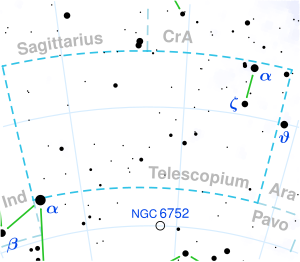
Back جليزا 784 Arabic Gliese 784 AST Gliese 784 Spanish Gliese 784 Basque גליזה 784 HE Gliese 784 Dutch Gliese 784 Swedish 格利泽784 Chinese
| Observation data Epoch J2000.0 Equinox J2000.0 | |
|---|---|
| Constellation | Telescopium |
| Right ascension | 20h 13m 53.396s[1] |
| Declination | −45° 09′ 50.47″[1] |
| Apparent magnitude (V) | 7.96[2] |
| Characteristics | |
| Spectral type | M0V[2] |
| B−V color index | 1.45[2] |
| Astrometry | |
| Radial velocity (Rv) | −33.5±0.5[1] km/s |
| Proper motion (μ) | RA: 778.331 mas/yr[1] Dec.: -159.939 mas/yr[1] |
| Parallax (π) | 162.2171 ± 0.0225 mas[1] |
| Distance | 20.106 ± 0.003 ly (6.1646 ± 0.0009 pc) |
| Absolute magnitude (MV) | 9.01[3] |
| Details | |
| Mass | 0.58[4] M☉ |
| Radius | 0.58[5] R☉ |
| Luminosity | 0.06[5] L☉ |
| Temperature | 3,754±92[6] K |
| Metallicity [Fe/H] | −0.07±0.06[6] dex |
| Rotation | 48±12[7] |
| Rotational velocity (v sin i) | 1.0[2] km/s |
| Age | 0.85±0.4[8] Gyr |
| Other designations | |
| Database references | |
| SIMBAD | data |
Location of Gliese 784 in the constellation Telescopium | |
Gliese 784 is a single[8] red dwarf star located in the southern constellation of Telescopium that may host an exoplanetary companion. The star was catalogued in 1900, when it was included in the Cordoba Durchmusterung (CD) by John M. Thome with the designation CD−45 13677.[10] It is too faint to be viewed with the naked eye, having an apparent visual magnitude of 7.96.[2] Gliese 784 is located at a distance of 20.1 light-years from the Sun as determined from parallax measurements, and is drifting closer with a radial velocity of −33.5 km/s.[1] The system is predicted to come as close as 11.4 light-years in ~121,700 years time.[11]
This is a small M-type main-sequence star with a stellar classification of M0V.[2] It is much younger than Sun at 0.85±0.4 billion years.[8] Despite this, it appears to be rotating slowly with a period of roughly 48 days.[7] The star has 58% of the mass and 58% of the radius of the Sun. It is radiating just 6%[5] of the luminosity of the Sun from its photosphere at an effective temperature of 3,754 K.[6]
- ^ a b c d e f Cite error: The named reference
EDR3was invoked but never defined (see the help page). - ^ a b c d e f Cite error: The named reference
Torres_et_al_2006was invoked but never defined (see the help page). - ^ Cite error: The named reference
Anderson_Francis_2012was invoked but never defined (see the help page). - ^ Cite error: The named reference
RECONSwas invoked but never defined (see the help page). - ^ a b c Cite error: The named reference
Gáspár_et_al_2016was invoked but never defined (see the help page). - ^ a b c Cite error: The named reference
Hojjatpanah_et_al_2019was invoked but never defined (see the help page). - ^ a b Cite error: The named reference
Byrne_Doyle_1989was invoked but never defined (see the help page). - ^ a b c Cite error: The named reference
Brems2019was invoked but never defined (see the help page). - ^ Cite error: The named reference
SIMBADwas invoked but never defined (see the help page). - ^ Cite error: The named reference
Thome1900was invoked but never defined (see the help page). - ^ Cite error: The named reference
Bailer_et_al_2018was invoked but never defined (see the help page).
© MMXXIII Rich X Search. We shall prevail. All rights reserved. Rich X Search
